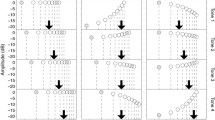Abstract
Pitch-height can be represented in a spatial format. Reaction times (RTs) to lower pitch-heights are faster when responses are executed in the lower side of space, whereas RTs to higher pitch-heights are faster when responses are executed in the upper side of space. This effect is called the Spatial-Music Association of Response Codes (SMARC) effect. We investigated how pitch-height and the brightness of a tone’s timbre might contribute in eliciting the SMARC effect as a function of music expertise by comparing the results of 24 musicians with the results we gathered previously (Pitteri et al., 2017) with 24 non-musicians. Three experimental conditions were used: pitch-height varied, brightness varied; pitch-height varied, brightness fixed; pitch-height fixed, brightness varied. We found that the coherent modulation of both pitch-height and brightness elicited the strongest SMARC effect, independently of music expertise. These results add evidence to the hypothesis that the strongest SMARC effect does not belong to pitch-height or brightness, but to pitch-height and brightness together.



Similar content being viewed by others
References
Bruzzi, E., Talamini, F., Priftis, K., & Grassi, M. (2017). A SMARC Effect for Loudness. I-Perception, 8(6), 204166951774217. https://doi.org/10.1177/2041669517742175.
Chang, S., & Cho, Y. S. (2015). Polarity correspondence effect between loudness and lateralized response set. Frontiers in Psychology, 6, 683. https://doi.org/10.3389/fpsyg.2015.00683.
Dehaene, S., Bossini, S., & Giraux, P. (1993). The mental representation of parity and number magnitude. Journal of Experimental Psychology: General, 122, 371–396. https://doi.org/10.1037/0096-3445.122.3.371.
Fernandez-Prieto, I., Spence, C., Pons, F., & Navarra, J. (2017). Does language influence the vertical representation of auditory pitch and loudness? i-Perception. https://doi.org/10.1177/2041669517716183.
Grassi, M., & Soranzo, A. (2009). MLP: A MATLAB toolbox for rapid and reliable auditory threshold estimation. Behavior Research Methods, 41(1), 20–28. https://doi.org/10.3758/BRM.41.1.20.
Hartmann, M. (2017). Non-musicians also have a piano in the head: Evidence for spatial–musical associations from line bisection tracking. Cognitive Processing, 18, 75–80. https://doi.org/10.1007/s10339-016-0779-0.
Hartmann, M., & Mast, F. W. (2017). Loudness counts: Interactions between loudness, number magnitude, and space. Quarterly Journal of Experimental Psychology, 70, 1305–1322. https://doi.org/10.1080/17470218.2016.1182194.
Lega, C., Cattaneo, Z., Ancona, N., Vecchi, T., & Rinaldi, L. (2020). Instrumental expertise and musical timbre modulate the spatial representation of pitch. Quarterly Journal of Experimental Psychology, 73(8), 1162–1172. https://doi.org/10.1177/1747021819897779.
Lidji, P., Kolinsky, R., Lochy, A., & Morais, J. (2007). Spatial associations for musical stimuli: A piano in the head? Journal of Experimental Psychology. Human Perception and Performance, 33, 1189–1207. https://doi.org/10.1037/0096-1523.33.5.1189.
Macnamara, A., Keage, H. A. D., & Loetscher, T. (2018). Mapping of non-numerical domains on space: A systematic review and meta-analysis. Experimental Brain Research, 236, 335–346. https://doi.org/10.1007/s00221-017-5154-6.
McAdams, S. (2013). Musical timbre perception. In D. Deutsch (Ed.), The psychology of music (pp. 35–67). San Diego: Elsevier/Academic Press.
McDermott, J. H., Lehr, A. J., & Oxenham, A. J. (2008). Is relative pitch specific to pitch? Psychological Science, 19, 1263–1271. https://doi.org/10.1111/j.1467-9280.2008.02235.x.
Micheyl, C., Delhommeau, K., Perrot, X., & Oxenham, A. J. (2006). Influence of musical and psychoacoustical training on pitch discrimination. Hearing Research, 219, 36–37. https://doi.org/10.1016/j.heares.2006.05.004.
O’Brien, F., & Cousineau, D. (2014). Representing error bars in within-subject designs in typical software packages. The Quantitative Methods for Psychology, 10(1), 56–67. https://doi.org/10.20982/tqmp.10.1.p056.
O’Brien, F., & Cousineau, D. (2015). Erratum to “Representing Error bars in within-subject designs in typical software packages”. The Quantitative Methods for Psychology, 11(2), 126. https://doi.org/10.20982/tqmp.11.2.p126.
Pitteri, M., Marchetti, M., Priftis, K., & Grassi, M. (2017). Naturally together: Pitch-height and brightness as coupled factors for eliciting the SMARC effect in non-musicians. Psychological Research, 81, 243–254. https://doi.org/10.1007/s00426-015-0713-6.
Proctor, R. W., & Cho, Y. S. (2006). Polarity correspondence: A general principle for performance of speeded binary classification tasks. Psychological Bulletin, 132, 416–442. https://doi.org/10.1037/0033-2909.132.3.416.
Prpic, V., & Domijan, D. (2018). Linear representation of pitch height in the SMARC effect. Psihologijske Teme, 27, 437–452.
Rusconi, E., Kwan, B., Giordano, B. L., Umiltà, C., & Butterworth, B. (2006). Spatial representation of pitch height: The SMARC effect. Cognition, 99, 113–129. https://doi.org/10.1016/j.cognition.2005.01.004.
Russo, F. A., & Thompson, W. F. (2005). An interval size illusion: The influence of timbre on the perceived size of melodic intervals. Perception and Psychophysics, 67, 559–568. https://doi.org/10.3758/BF03193514.
Soranzo, A., & Grassi, M. (2014). PSYCHOACOUSTICS: A comprehensive MATLAB toolbox for auditory testing. Frontiers in Psychology, 5, 712. https://doi.org/10.3389/fpsyg.2014.00712.
JASP Team (2020). JASP (Version 0.13.1) [Computer software]. https://jasp-stats.org/.
Timmers, R., & Li, S. (2016). Representation of pitch in horizontal space and its dependence on musical and instrumental experience. Psychomusicology: Music, Mind, and Brain, 26, 139–148. https://doi.org/10.1037/pmu0000146.
Umiltà, C., Priftis, K., & Zorzi, M. (2009). The spatial representation of numbers: Evidence from neglect and pseudoneglect. Experimental Brain Research, 192, 561–569. https://doi.org/10.1007/s00221-008-1623-2.
Vallesi, A., Binns, M. A., & Shallice, T. (2008). An effect of spatial-temporal association of response codes: Understanding the cognitive representations of time. Cognition, 107, 501–527. https://doi.org/10.1016/j.cognition.2007.10.011.
Van Selst, M., & Jolicoeur, P. (1994). A solution to the effect of sample size on outlier elimination. The Quarterly Journal of Experimental Psychology Section A, 47(3), 631–650.
Wagenmakers, E.-J., Love, J., Marsman, M., Jamil, T., Ly, A., Verhagen, J., et al. (2018). Bayesian inference for psychology. Part II: Example applications with JASP. Psychonomic Bulletin & Review, 25, 58–76. https://doi.org/10.3758/s13423-017-1323-7.
Winter, B., Matlock, T., Shaki, S., & Fischer, M. H. (2015). Mental number space in three dimensions. Neuroscience and Biobehavioral Reviews, 57, 209–219. https://doi.org/10.1016/j.neubiorev.2015.09.005.
Acknowledgements
We would like to thank: Michele Scaltritti, Ph.D., for helping us with RTs analysis; Beatrice Barbazzeni, Camilla Santini, and Chiara Simonetto for their help in data gathering; all the participants for their time and effort. Also this study is dedicated to the beloved memory of our colleague and friend Mauro Marchetti. The elaborated data are freely available from the Open Science Framework at the following link: https://osf.io/djgkx/?view_only=ed15c5ed83924c9d8e1472a498d050ee. This work was carried out within the scope of the project ‘use-inspired basic research’, for which the Department of General Psychology of the University of Padova has been recognized as ‘Department of Excellence’ by the Italian Ministry of University and Research.
Author information
Authors and Affiliations
Corresponding author
Ethics declarations
Conflict of interest
The authors declare that they have no conflict of interest.
Ethical approval
All procedures performed in the present study, which involves human participants, were in accordance with the ethical standards of the institutional and/or national research committee and with the 1964 Helsinki declaration and its later amendments or comparable ethical standards.
Informed consent
Informed consent was obtained from all individual participants included in the study.
Additional information
Publisher's Note
Springer Nature remains neutral with regard to jurisdictional claims in published maps and institutional affiliations.
The elaborated data are freely available from the Open Science Framework at the following link: https://osf.io/djgkx/?view_only=ed15c5ed83924c9d8e1472a498d050ee.
Electronic supplementary material
Below is the link to the electronic supplementary material.
Rights and permissions
About this article
Cite this article
Pitteri, M., Marchetti, M., Grassi, M. et al. Pitch height and brightness both contribute to elicit the SMARC effect: a replication study with expert musicians. Psychological Research 85, 2213–2222 (2021). https://doi.org/10.1007/s00426-020-01395-0
Received:
Accepted:
Published:
Issue Date:
DOI: https://doi.org/10.1007/s00426-020-01395-0




